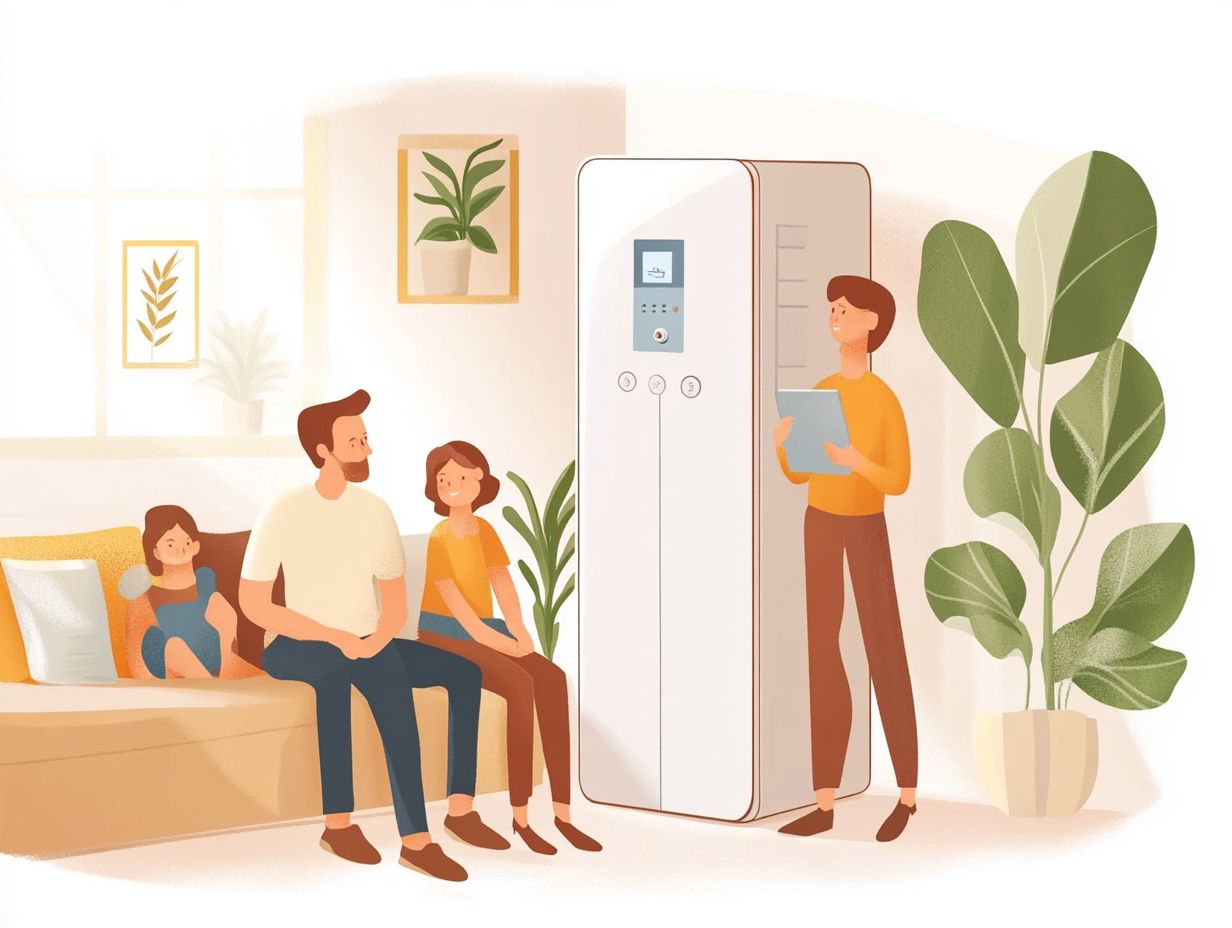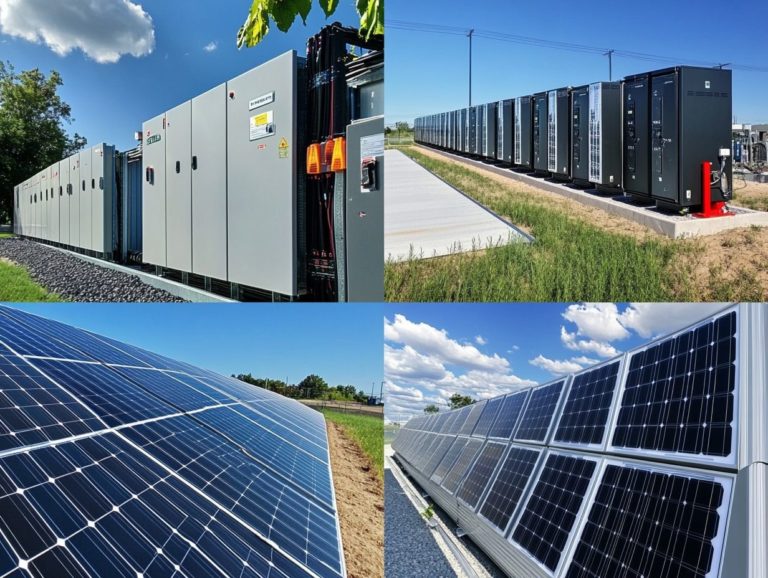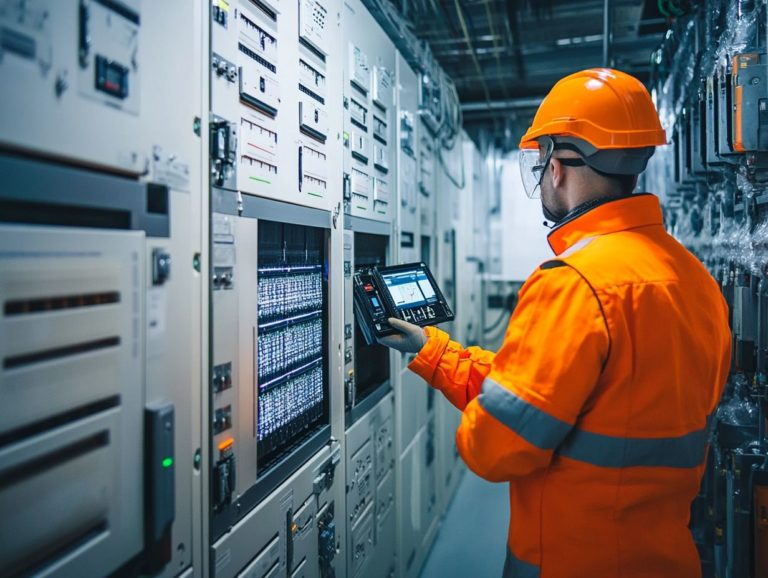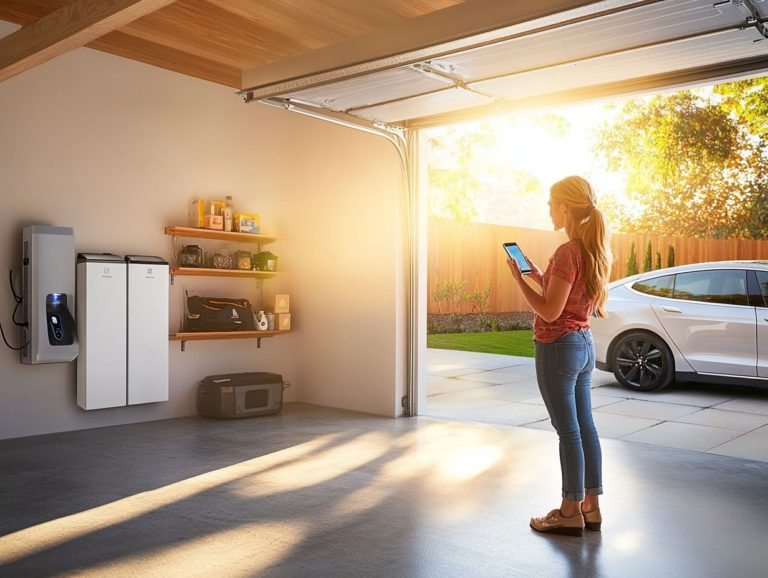Understanding Energy Storage Technologies for Homes
Energy storage technologies are revolutionizing the way you manage energy in your home. They present a wealth of benefits that can significantly enhance both efficiency and resilience. This is particularly important for reducing dependency on traditional energy infrastructures.
By reducing energy costs and offering backup power during outages, these systems are becoming essential for contemporary households. This is especially true through the integration of battery energy storage solutions.
This article delves into various energy storage options, such as:
- Battery energy storage systems
- Thermal energy storage
- Pumped hydroelectric systems
We will also explore emerging technologies like hydrogen energy storage while addressing crucial factors to consider before installation.
Get valuable tips on installation and maintenance designed to help you maximize your investment.
Explore how energy storage, including grid-connected options, can truly transform your home and learn about the future of home energy management with smart tech!
Contents
- Key Takeaways:
- Benefits of Energy Storage for Homes
- Types of Energy Storage Technologies
- Factors to Consider Before Installing Energy Storage
- Installation and Maintenance of Energy Storage Systems
- Frequently Asked Questions
- What is the purpose of understanding energy storage technologies for homes?
- What are the different types of energy storage technologies for homes?
- How do these technologies benefit homeowners?
- What factors should be considered when choosing an energy storage technology for a home?
- Are there any government programs or incentives for using energy storage technologies for homes?
- Can energy storage technologies be integrated with renewable energy sources?
Key Takeaways:

- Reduce your energy costs with home energy storage technologies that provide backup power during outages, especially with advanced chemistry batteries.
- Common types of energy storage include:
- Battery energy storage systems
- Thermal energy storage
- Pumped hydroelectric storage
- Consider factors such as energy requirements, costs, return on investment, and compatibility with existing systems before installation.
- Ensure proper installation, whether by a professional or DIY, and perform regular maintenance for optimal performance of energy storage systems.
What are Energy Storage Technologies?
Energy storage technologies represent a variety of options designed to capture and store energy for later use. They play a pivotal role in enhancing the efficiency of electricity supply. Common forms of energy storage include battery energy storage systems, like lithium-ion batteries, which are rechargeable batteries found in many devices, and advanced chemistry batteries, along with thermal energy storage and pumped hydro systems.
These technologies not only facilitate the integration of renewable energy sources such as solar power and photovoltaic systems but also reduce reliance on traditional energy infrastructures. This ultimately leads to improved energy self-consumption and management.
Among these solutions, electrochemical storage, especially through lithium-ion and flow batteries, stands out for its high energy density and rapid response times. This makes it ideal for both commercial and residential applications. Additionally, exploring the future of home energy efficiency solutions can enhance our understanding of how thermal energy storage systems intelligently capture heat for later use, playing a crucial role in balancing energy supply from solar thermal plants and enhancing overall energy management.
Hydrogen energy storage presents a flexible option by storing energy over extended periods. It converts electricity into hydrogen gas, which can later be utilized in fuel cells. For those looking to adopt more sustainable practices, understanding how to integrate renewable energy into homes is valuable. Pumped hydropower, one of the oldest techniques, harnesses the gravitational potential of water to store energy, making it exceptionally relevant for large-scale energy management.
Together, these technologies contribute to a more resilient energy landscape, promoting sustainability and efficiency across various sectors.
Benefits of Energy Storage for Homes
Embracing energy storage solutions in your home offers a wealth of advantages. These solutions primarily enhance your energy self-consumption while diminishing reliance on external electricity sources, particularly through monitoring and management tools.
By integrating battery storage systems, you can significantly lower your energy expenses. These systems enable you to optimize electricity usage, especially during peak demand times, and provide a reliable backup power source during outages, further emphasizing the importance of grid integration.
Don’t miss out on the advantages of these essential systems! Start your journey towards energy independence today!
Reduced Energy Costs
Reduced energy costs stand out as a compelling advantage of implementing energy storage systems, which are systems that store energy for later use, especially for homeowners eager to optimize their energy self-consumption.
By storing the excess electricity generated from solar power or other renewable sources, you can dramatically cut down on your reliance on grid electricity. This is particularly beneficial during peak pricing periods.
This transition not only leads to lower monthly utility bills but also boosts your energy efficiency. Smart homeowners can save 30% to 50% on energy costs!
For example, utilizing battery storage allows you to take advantage of lower electricity rates during off-peak hours. You can deploy that stored energy when rates spike, achieving a balance that could save you thousands annually.
As energy storage solutions gain traction, they play a crucial role in creating a sustainable energy future. By alleviating strain on the grid and encouraging the adoption of renewable technologies, you contribute to enhanced energy reliability and greenhouse gas reduction efforts. This makes a positive impact for both your wallet and the planet. Embracing innovations like the future of energy efficiency through smart homes can further amplify these benefits.
Backup Power
Backup power solutions offered by energy storage technologies are truly invaluable, particularly during grid outages or emergencies. These systems keep your electricity flowing, so life goes on smoothly.
Imagine having battery storage systems that can automatically activate, keeping your critical devices and appliances running seamlessly. These systems can support a wide array of appliances from refrigerators and heating systems to medical devices and home security systems. Learning about solar energy storage: pros and cons can help you make informed decisions about these systems.
You have a choice beyond traditional lead-acid batteries; options like lithium-ion and flow batteries are at your fingertips, each providing unique advantages in terms of efficiency and longevity.
By understanding the specifications and capacities of these energy storage technologies, including mechanical systems and flywheels, you can effectively safeguard your home against unexpected power interruptions. Implementing smart energy solutions for modern homes enhances your overall energy resilience.
Types of Energy Storage Technologies

Energy storage includes various technologies, each with unique benefits that improve energy management and grid integration. This includes utility-scale systems and compressed air technologies. Among the most notable examples are battery storage systems, such as lithium-ion batteries, which find extensive use in both residential and commercial environments.
Pumped hydro and thermal energy storage systems are also key in large-scale energy storage solutions, underscoring their importance in the broader energy landscape.
Batteries
Batteries are crucial for storing energy efficiently, with lithium-ion and flow batteries leading the way in both residential and commercial applications. These systems allow you to harness surplus energy from renewable sources like solar power, enhancing your energy capacity.
Beyond lithium-ion and flow batteries, you ll find other types such as lead-acid and nickel-metal hydride. Each plays a vital role with varying degrees of efficiency, longevity, and cost-effectiveness.
For example, lead-acid batteries are often a popular choice due to their low initial cost; however, their shorter lifespan makes them less ideal for long-term applications when compared to lithium-ion options, especially in the context of the energy storage industry.
Innovations in battery technology, including the emergence of solid-state and high-capacity systems, have significantly enhanced energy density and safety. These improvements tackle some of the age-old challenges faced in the industry.
As the demand for energy storage continues to rise, ongoing advancements are paving the way for more sustainable solutions. These not only cater to the needs of electric vehicles but also bolster grid stability, offering emerging technologies such as smart energy solutions for the modern home that enhance energy innovations.
Thermal Energy Storage
Thermal energy storage is a groundbreaking technology that captures and retains heat energy for later use. It significantly aids in managing electricity supply and consumption. By utilizing materials like molten salts or water, these systems store excess thermal energy generated from renewable sources. They can release this energy when necessary.
This capability is key to balancing supply and demand, especially as intermittent energy sources like solar and wind gain traction. For example, a solar thermal plant can store captured heat during peak sunlight hours. This enables electricity generation even on cloudy days or after the sun has set, showcasing innovations in the future of energy storage.
Cities like San Diego have successfully implemented large-scale thermal storage systems. These systems showcase reduced dependence on fossil fuels and bolster grid stability, contributing to the promotion of energy innovations. To further understand this technology, understanding energy storage is essential, as thermal energy storage systems are increasingly acknowledged as essential in the global push toward sustainable energy practices.
Pumped Hydroelectric Storage
Pumped hydroelectric storage is one of the most established and widely embraced energy storage technologies. It harnesses the energy stored in water that is held high up to store water in elevated reservoirs. When electricity demand dips, you can utilize excess electricity to pump water uphill. This sets the stage for its release to generate power during peak demand periods.
This approach offers a reliable backup resource to meet fluctuating energy needs. It also plays a crucial role in integrating renewable energy sources, such as wind and solar power, enhancing the overall energy infrastructure. By effectively balancing supply and demand, pumped hydro systems significantly enhance grid reliability, stabilizing the energy grid amid the growing variability tied to renewables.
While the technology has challenges, including high initial capital costs and geographical constraints, it offers impressive benefits, like a long lifespan and substantial energy capacity. This positions it as a key player in the rapidly evolving energy storage landscape.
Factors to Consider Before Installing Energy Storage
Before installing energy storage solutions, consider several key factors, such as costs, return on investment, and compatibility with your existing energy management systems.
By thoroughly analyzing these elements, you enable yourself to make informed decisions that align seamlessly with your unique energy needs and long-term objectives.
Costs and Return on Investment

Understanding the costs associated with energy storage solutions and calculating your return on investment is essential for anyone thinking about these systems for their home. These costs typically encompass installation, maintenance, and the purchase of technology like lithium-ion batteries.
You should weigh that initial investment against the long-term savings on your energy bills, as this can significantly influence your financial choices. Explore various incentives, such as federal tax credits or state-specific rebates, to help reduce those upfront expenses.
Financing options, including low-interest loans, are becoming increasingly available. This makes energy storage more accessible than ever. Analyzing the total cost of ownership alongside the longevity of the technology will give you a clearer understanding of how energy storage can enhance your energy independence while potentially leading to substantial savings over time. Exploring DIY solutions for home energy storage can also contribute to these benefits.
Compatibility with Existing Systems
Ensuring that your energy storage solutions are compatible with existing systems is vital for achieving optimal performance and effective energy management. Your systems should seamlessly connect with solar power installations or other renewable energy sources to maximize self-consumption and efficiency.
When integrating inverters, batteries, and grid components, assessing the specifications and protocols of each element is crucial. A high-quality inverter effectively converts DC from solar panels into usable AC, ensuring energy flows without interruption.
Take the Tesla Powerwall. Its integration with various solar systems enhances energy autonomy and promotes efficient interaction with the grid. Successful projects show that selecting compatible technologies can significantly reduce energy costs and boost overall reliability.
As energy demands evolve, understanding these technical details is essential for both residential and commercial applications.
Installation and Maintenance of Energy Storage Systems
The installation and maintenance of energy storage systems are essential for maximizing their longevity and efficiency. Whether you choose professional installation or the DIY route, a meticulous setup is key.
Consistent upkeep greatly influences the performance and reliability of systems like lithium-ion batteries and other advanced energy storage technologies.
Professional Installation vs DIY
Choosing between professional installation and DIY for energy storage systems requires careful consideration of costs, safety, and efficiency. Professional installation brings expertise and ensures compliance with safety standards.
A DIY approach may reduce upfront expenses but carries risks if not executed properly. The initial savings can be enticing, but it s important to acknowledge the level of technical skill required for a successful installation.
Missteps could result in significant performance issues or safety hazards, negating any financial advantages. On the other hand, opting for a professional installer might mean higher initial costs, but this choice often guarantees optimized system performance and longevity.
Expert installation typically comes with warranties or support services, providing peace of mind regarding ongoing system functionality and reliability.
Regular Maintenance and Upkeep
Regular maintenance of your energy storage systems is crucial for optimal performance and longevity, especially with technologies like battery energy storage and thermal systems. Neglecting maintenance risks efficiency losses and higher costs.
For battery energy storage, routine assessments of battery health are essential. Variations in temperature and charge cycles can significantly impact performance. Regularly checking electrolyte levels and ensuring proper ventilation helps mitigate deterioration.
Implementing performance checks by measuring voltage and capacity is vital for maintaining system efficiency. Monitoring the integrity of thermal insulation and fluid levels provides valuable insights into potential leaks or energy losses.
Committing to these tasks enhances energy reliability and minimizes the risk of unexpected outages, leading to a more cost-effective energy storage solution.
Frequently Asked Questions

What is the purpose of understanding energy storage technologies for homes?
Understanding energy storage technologies for homes is essential for individuals looking to reduce energy costs, become more self-sufficient, or contribute to a greener environment. It helps homeowners make informed decisions on which technology is best suited for their needs and budget.
What are the different types of energy storage technologies for homes?
The most common types of energy storage technologies for homes include batteries, pumped hydro storage, compressed air energy storage, and flywheel energy storage.
Each technology has its own advantages and disadvantages. Research is crucial to selecting the best option for your situation.
How do these technologies benefit homeowners?
Energy storage technologies provide various benefits for homeowners. They reduce energy costs by using stored energy during peak hours when rates are higher.
These technologies also provide backup power during outages. They help reduce the need for traditional energy sources, promoting a sustainable lifestyle.
What factors should be considered when choosing an energy storage technology for a home?
When choosing an energy storage technology, consider factors like upfront cost, maintenance, and expected lifespan.
Compatibility with your home’s existing energy system is essential. Consult a professional to find the best option for your needs.
Are there any government programs or incentives for using energy storage technologies for homes?
Yes, there are government programs and incentives for homeowners installing energy storage technologies.
These can include tax credits, rebates, and grants. Researching these options can make your investment more affordable. Don t miss out on the available incentives!
Can energy storage technologies be integrated with renewable energy sources?
Yes, most energy storage technologies integrate with renewable sources like solar panels or wind turbines.
This integration allows homeowners to store excess energy generated and use it later, reducing reliance on traditional sources. Act now to secure your energy future!






